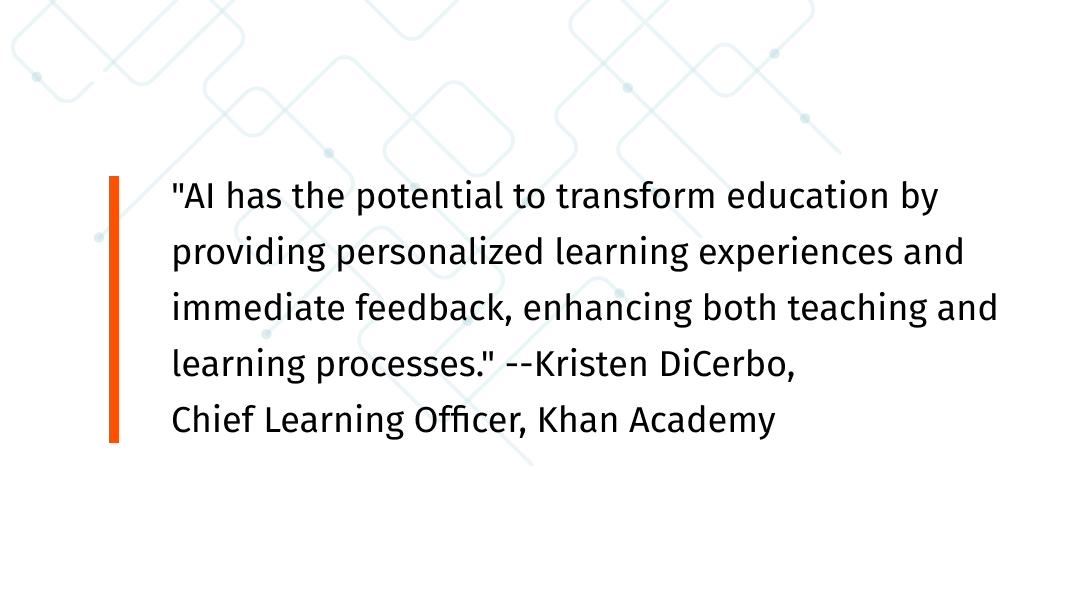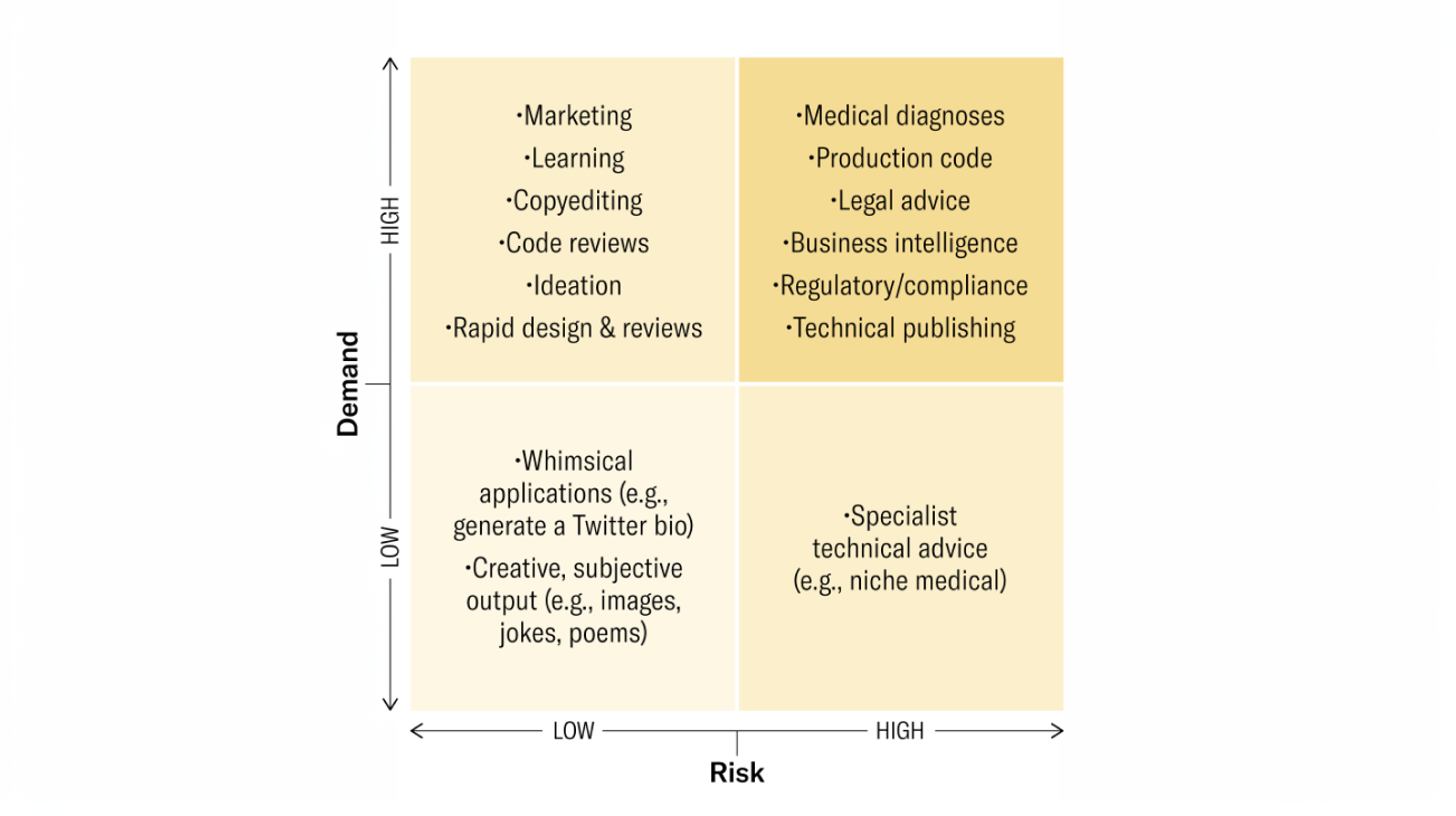
Table of Contents
Part 1: Introduction
Part 2: The Era of AI: Now and Tomorrow
Part 3: How AI is Transforming Higher Education
Part 4: The Future of Work
Part 5: The AI Strategy and Adoption Plan


AI is evolving too fast for business-as-usual procurement and implementation.
You’ve seen the movie over and over.
The latest and greatest must-have software or technology comes along.
One or two departments clamor for it. Others are against it. Many are indifferent because they’ve seen the same movie.
Fast forward a year and a vendor is selected.
A year after that, the vendor collects the requirements you already gathered and you get a report about things you already knew.
Eventually, you’re presented with what you originally asked for. Your needs have since evolved, as has the technology.
But everyone forges ahead because what else is there to do?
If you’re lucky, you get to use the “new” technology three or four years after you originally sought it out. The rollout has its own headaches and most people get away with knowing the bare minimum of the platform to do their jobs. A handful of power users become your in-house technical support. Everyone worries when they go on vacation.
Here, we offer an alternative.
Start Now
One of the first things we recommend is getting your employees — at every level, in every department — familiar with AI. Demystify it. Educate them so they are informed when it comes time for bigger AI investments.
Assure employees that AI isn’t replacing them.
The ultimate goal, one worth over-communicating, is that AI will do the boring, time-consuming tasks no one likes.
A few steps you can take immediately:
Encourage employees to explore free generative AI tools.
Ask your department leads to let their staff play around with tools like ChatGPT and Gemini as part of their workweek. Be clear that there are no expectations or rigid goals. They can try to complete aspects of their regular jobs with AI assistance or do more generic activities. The point is to build confidence and awareness. Give them a pizza party where they can talk about what they learned that week. Make it fun!
Empower managers and employees to attend online AI workshops and training.
Again, this doesn’t need to be a formal process with strict guidelines. Simply let your teams find low-commitment opportunities to learn how to use AI. LinkedIn continues to expand its AI-related content. They now offer a "Career Essentials in Generative AI" learning path developed in partnership with Microsoft. This includes 6 courses covering about 5 hours of content on generative AI fundamentals, ethics, and practical applications. There are more specialized offerings, too from agencies. Marketing, admissions, and enrollment, in particular, are great matches for generative AI techniques.
For faculty and staff who work closely with them, Google, in collaboration with MIT RAISE, offers a free 2-hour self-paced course specifically designed for educators. It covers practical applications of generative AI in teaching, including time-saving techniques and ways to enhance lessons.
Pick a generative AI project.
This could be at a school-wide or department level. Find something to get teams to collaborate on. Harvard Business Review offers a helpful matrix for deciding what projects make sense for your organization.
Picking a Generative AI Project
Balancing risk and demand

Think Bigger
Small steps like those listed above will help you build a culture of AI for the eventual investments you’ll make in products and services.
Similar to the demand assessment you made in picking a generative AI project, you can look to your strategic plan to flag initiatives where AI will accelerate your ambitions.
Once you’ve selected areas where AI offers the most visible, easily realized benefits (admissions and enrollment chatbots, for example), break the mold of traditional vendor selection.
Again, it’s important to balance risk and reward here.
You don’t need to invest in huge contracts spanning many years.
Choose partnerships with vendors who understand higher education and have forward-looking, user-friendly, hyper-secure products.
Also, be prepared for the change management required to get people on board with adopting AI at a bigger scale. There will naturally be an adjustment period as new software becomes part of their routine.
A Checklist for Selecting AI
When you start a technology search with a clear, strategic goal in mind, it’s much easier to steady your sights on the right product and vendor. To make it an even clearer choice, use this checklist to ensure success.
1. Frequent feature enhancements.
With fast-moving technology like AI, you need a product that’s designed to serve your needs in 3 months, 6 months, a year, and beyond.
2. Higher ed innovators.
It’s critical to find a partner that’s not only technically proficient but also plugged into higher ed. It shouldn’t be your job as a client to tell the vendor what’s happening in the world of colleges and universities.
3. Security obsessed.
There’s no room for security breaches in higher ed. Prospect and student data is extremely sensitive and can’t be compromised.
4. User advocates.
Whether it’s employees, faculty, or students using the product, they shouldn’t have to think very hard to complete tasks. Weeks of user training are the antithesis of AI.
5. Success minded.
Sure, you want technical support for advanced functionality, but what you really need is a partner that understands the tools it’s providing serve a business goal.
6. Integration ready.
Data drives AI. Your existing systems must “talk” with any new tech you purchase.
7. Reputable.
Ask around. What do other schools say about the company?
8. Mature.
It’s easy for new entrants into ed tech to claim AI experience and capabilities. Don’t take their word for it. You need a partner that has been developing AI functionality long before the ChatGPT hype.
9. Realistic.
AI isn’t magic. The challenges facing higher ed are larger than any piece of software. Find a vendor that is realistic about what it can and can’t do for you.
10. Easy to work with.
Gone are the days when it was acceptable for vendors to speak in jargon.
Stories of Early Adopters
Schools are already benefiting from AI’s value. So are their students. Here are a few highlights from our own client community.

Wake Technical Community College
The largest community college in North Carolina introduced AI Assistants to create more tailored communications to students.
Kathy Taylor, Admissions Technology & Training Manager, notes that before using AI Assistants, communication was limited and often confusing for students.
She says that “now, with Element451, Wake Tech can send personalized, step-by-step guidance through AI-powered workflows. This change has significantly improved how students navigate the admissions process, reducing confusion and improving their overall experience.”
Wake Tech is excited about adopting a new AI-first student success platform, StudentHub, which is expected to further enhance personalized student engagement. StudentHub will provide students with 24/7 assistance across their physical and virtual campus.
Guilford Technical Community College
Another North Carolina school, Guilford Technical Community College, uses AI products to improve retention.
Part one is a conversational AI chatbot that “handles nearly 1,000 monthly conversations, addressing common student concerns about registration, financial aid, and class schedules,” explains Orna Collins.
Because its always online, students get immediate attention and helpful guidance no matter the day or time they seek them. This contributes to students returning and continuing their education.
The next part – and one that exemplifies the richness of AI tools – is that Guilford uses AI to analyze the collected data to continuously improve school communications.
For example, Guilford identifies which services students use most, and which information they access often. That feedback allows Guilford to adapt its communications and resources accordingly. For example, calling attention to frequently-used content knowing that it’s likely that students want it. They also examine lesser-used resources to see if they need to be improved or removed, making more use of their communication channels.
Texas State Technical College
Michael Bettersworth, Senior Vice Chancellor & Chief Marketing Officer, describes how AI-powered chat automated answers to frequently asked questions has reduced staff workload”
“This also positively impacts staff productivity by allowing them to focus on more complex and personalized student interactions, rather than handling repetitive inquiries.”
AI is part of Texas State’s application management process too. Bettersworth says:
“By using AI to customize the application process and pre-qualify leads, TSTC ensures that the right students are matched with the right programs. This not only boosts the overall conversion rate but also ensures that prospective students have a clearer understanding of their program choices, improving the likelihood that they will persist through to enrollment.”

Governance and Policy
The potential for AI to enhance the student experience, streamline administrative processes, and drive innovation in higher education is immense. However, these benefits come with ethical and privacy concerns.
We recommend having clear-eyed conversations and establishing governance and policies around AI usage.
This step is critical in adopting AI successfully and managing the inherent risks that come with new technology and new ways of working.
AI governance strategies should be both robust and flexible. They should help foster an innovative culture that simultaneously safeguards an institution’s core values and the interests of their diverse stakeholders.
Here are key recommendations and best practices for developing, implementing, and managing such a strategy at your institution:
Establish a Cross-Functional AI Governance Committee
Form a diverse committee with representatives from various departments, including:
- Information technology
- Legal and compliance
- Student services
- Admissions and marketing
- Academic affairs
- Faculty representatives
This committee should oversee AI initiatives, develop policies, and ensure alignment with institutional values and goals.
Develop Comprehensive AI Policies
Create clear, flexible policies that address:
- Ethical use of AI
- Data privacy and security
- Transparency and explainability
- Fairness and non-discrimination
- Academic integrity
- Responsible AI development and deployment
Ensure these policies are regularly reviewed and updated to keep pace with evolving AI technologies.
Conduct an AI Governance Maturity Assessment
Perform a thorough evaluation of your institution's current AI landscape to:
- Identify strengths and weaknesses
- Pinpoint areas for improvement
- Establish a baseline for measuring progress
Provide AI Education and Training
Implement comprehensive AI literacy programs for faculty, staff, and students:
- Offer workshops on AI fundamentals and ethical considerations
- Provide role-specific training for administrators and key stakeholders
- Develop (or curate from other sources) on-demand courses for ongoing education
Implement Monitoring and Compliance Mechanisms
Establish robust systems to:
- Monitor AI applications across campus
- Ensure compliance with institutional policies and relevant regulations
- Regularly audit AI systems for potential biases or risks
Foster Transparency and Stakeholder Engagement
- Clearly communicate AI initiatives and their potential impact to all stakeholders
- Engage students, faculty, and staff in policy development and decision-making processes
- Encourage open dialogue about AI use and its implications
Develop AI Use Guidelines for Specific Functions
Create tailored guidelines for AI use in different areas. For example:
- Admissions: Ensure fair and transparent use of AI in application review processes
- Marketing: Establish ethical standards for AI-driven personalization and targeting
- Student Services: Define appropriate use of AI in academic advising and support
Establish Ethical Review Processes
Implement a review system, similar to Institutional Review Boards (IRBs), to:
- Evaluate proposed AI applications for ethical concerns
- Ensure alignment with institutional values and policies
- Provide guidance on responsible AI implementation

Measuring Success
KPIs
Key Performance Indicators (KPIs) are crucial when launching AI initiatives in higher education. They provide objective measures to assess the effectiveness and impact of AI activities and investments.
KPIs for AI initiatives will help your institution align its AI projects with strategic goals, enable data-driven decision-making, and facilitate continuous improvement (more on that in the next section).
By tracking relevant metrics, colleges and universities can justify their AI investments, identify areas for enhancement, and demonstrate tangible benefits to stakeholders.
Well-defined KPIs also allow institutions to benchmark their progress against industry standards and peer institutions, ensuring they remain competitive in an increasingly tech-driven educational landscape.
Here are some relevant KPIs for various areas of your school’s operations. The KPIs will likely be familiar to your organization. What’s distinct here is that you will be measuring the activities as they relate to artificial intelligence tools and strategies you roll out.
Admissions
- Application completion rate
- Yield rate
- Time to decision for applications
- Diversity of applicant pool
Marketing
- Engagement rate on AI-powered personalized content
- Conversion rate from website visitors to applicants
- Cost per enrolled student
Student Success
- Retention rate
- Graduation rate
- Student satisfaction scores
Implementing KPIs
With your KPIs identified, it’s time to implement them. If you already have an implementation approach that works for your organization, definitely use it here.
If you don’t have one, or want to refresh it, follow these recommendations.
The goal of successfully implementing KPIs is to validate the success of AI projects as well as guide future developments, ultimately leading to improved operational efficiency, enhanced student experiences, and better overall outcomes.
- Establish a dedicated team responsible for monitoring and reporting on AI-related KPIs, including representatives from IT, admissions, marketing, and student affairs.
- Collect and report on KPIs monthly or quarterly, depending on the specific metric and institutional needs.
- Use data visualization tools to create dashboards for easy interpretation and sharing of KPI data.
- Conduct quarterly reviews with leadership to assess progress and make data-driven decisions on AI initiatives.
- Annually evaluate the relevance and effectiveness of chosen KPIs, adjusting as necessary to align with evolving institutional goals and AI capabilities.
- Benchmark KPIs against peer institutions and industry standards to gauge relative performance and identify areas for improvement.
- Implement a feedback loop to continuously refine AI models and processes based on KPI insights.
Continuous Improvement with AI
The term “continuous improvement” is fairly self explanatory. But it does have special meaning in the world of technology. It refers to the ongoing process of refining and optimizing AI-driven systems and workflows to achieve better outcomes over time. The beneficiaries being students, staff, and faculty.
The KPIs you establish will be a key component of continuous improvement, as you’ll see in the following sections.
Key Principles of Continuous Improvement with Artificial Intelligence
Feedback Loop Integration
Continuously gathering feedback from AI tools and stakeholders to improve processes and outcomes.
Data-Driven Decision Making
Using AI-generated insights to make informed and iterative decisions.
Efficiency Optimization
Implementing AI to streamline administrative tasks, freeing up resources for direct student engagement.
Scalability
Ensuring that AI systems can scale to accommodate growing data and user demands.
Benefits of Continuous Improvement with AI
Adopting a continuous improvement mindset when implementing AI in higher education can lead to:
Enhanced Student Satisfaction
Personalized communications and academic support can lead to improved academic outcomes.
Increased Operational Efficiencies
Automating repetitive tasks reduces administrative workload, allowing staff to focus on high-value activities.
Real-Time Feedback
AI systems can provide immediate insights to both instructors and students, enabling timely interventions and adjustments.
Cost Savings
By optimizing resources and reducing manual processes, institutions can realize significant cost savings over time.
Improved Decision Making
Data analytics powered by AI help in making more informed and strategic choices at all levels of the institution.
Practical Suggestions for Implementation
To effectively implement continuous improvement strategies using AI tools in higher education, consider the following:
Establish Clear Objectives
Define specific goals for what you want the AI system to achieve in terms of improvement. This will help guide your efforts and measure success.
Create a Cross-Functional Team
Include diverse roles such as IT professionals, faculty members, and administrators to facilitate holistic improvements across the institution.
Invest in Regular Training
Provide ongoing training for staff to ensure they can fully leverage AI tools and adapt to new processes.
Monitor Progress Consistently
Regularly review KPI reports and refine strategies based on performance data. This allows for timely adjustments and ensures the AI systems are meeting their intended goals.
Foster a Culture of Innovation
Encourage an environment where experimentation with AI tools is welcomed and supported. This can lead to creative solutions and continuous advancement.
Actively Solicit Feedback
Seek input from students, faculty, and staff on the effectiveness of AI tools and areas for improvement. This firsthand feedback is invaluable for refining AI implementations.
Analyze and Act on Data
Regularly analyze trends and outcomes from AI implementations to make informed adjustments. Use this data to drive decision-making and strategy refinement.
Share Best Practices
Facilitate communication among departments to share successful strategies and technologies across the institution. This cross-pollination of ideas can accelerate improvement and innovation.
A publication by Element451 ©️2024.
Contact us to learn how our AI-first CRM and student engagement platform can transform your school.

